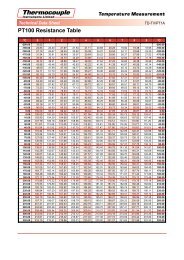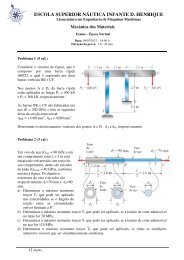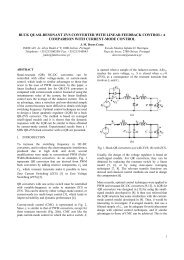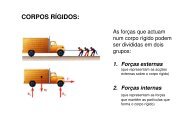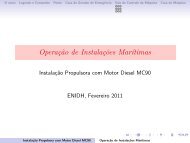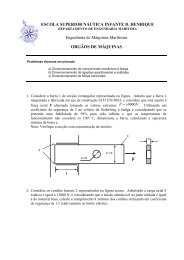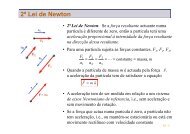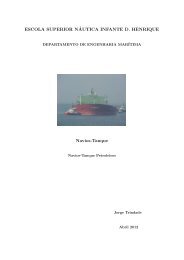Textos de Apoio (pdf)
Textos de Apoio (pdf)
Textos de Apoio (pdf)
You also want an ePaper? Increase the reach of your titles
YUMPU automatically turns print PDFs into web optimized ePapers that Google loves.
V and engine speed n will increase in<br />
accordance with the propeller law (more<br />
or less valid for the normal speed range):<br />
3.<br />
5<br />
VS<br />
0<br />
= V × 115 . = 1041 . × V<br />
3.<br />
0<br />
n = n× 115 . = 1048 . × n<br />
S 0<br />
Engine shaft power % of A<br />
Point S0 will be placed on the same<br />
propeller curve as point PD.<br />
Sea running with clean hull and 15%<br />
sea margin, point S 2<br />
Conversely, if still operating with loa<strong>de</strong>d<br />
ship and clean hull, but now with extra<br />
PD: Propeller <strong>de</strong>sign point, clean hull and calm weather<br />
Continuous service rating for propulsion with<br />
a power equal to 90% specified MCR, based on:<br />
S0: Clean hull and calm weather, loa<strong>de</strong>d ship<br />
S1: Clean hull and calm weather, ballast (trial)<br />
S2: Clean hull and 15% sea margin, loa<strong>de</strong>d ship<br />
SP: Fouled hull and heavy weather, loa<strong>de</strong>d ship<br />
S3: Very heavy sea and wave resistance<br />
110<br />
100% ref. point (A)<br />
Specified MCR (M)<br />
105<br />
100<br />
A=M<br />
5<br />
7<br />
95<br />
S0<br />
S1<br />
90<br />
S2<br />
85<br />
SP<br />
S3<br />
8 4 1 6<br />
80<br />
2<br />
PD<br />
3 9<br />
75<br />
6.3<br />
6.2 6.1<br />
70<br />
80 85 90 95 100 105 110<br />
Engine speed, % of A<br />
Line 1: Propeller curve through point A=M, layout curve for engine<br />
Line 2: Heavy propeller curve, fouled hull and heavy weather, loa<strong>de</strong>d ship<br />
Line 6: Light propeller curve, clean hull and calm weather,<br />
loa<strong>de</strong>d ship, layout curve for propeller<br />
Line 6.1: Propeller curve, clean hull and calm weather, ballast (trial)<br />
Line 6.2: Propeller curve, clean hull and 15% sea margin, loa<strong>de</strong>d ship<br />
Line 6.3: Propeller curve, very heavy sea and wave resistance<br />
Fig. 24: Influence of different types of ship resistance on the continuous service rating<br />
resistance from heavy seas, an extra<br />
power of, for example, 15% is nee<strong>de</strong>d<br />
in or<strong>de</strong>r to maintain the ship speed V<br />
(15% sea margin).<br />
As the ship speed V S2<br />
= V, and if the<br />
propeller had no slip, it would be expected<br />
that the engine (propeller) speed would<br />
also be constant. However, as the water<br />
does yield, i.e. the propeller has a slip,<br />
the engine speed will increase and the<br />
running point S2 will be placed on a<br />
propeller curve 6.2 very close to S0, on<br />
propeller curve 6. Propeller curve 6.2<br />
will possibly represent an approximate<br />
0.5% heavier running propeller than<br />
curve 6.<br />
Depending on the ship type and size,<br />
the heavy running factor of 0.5% may<br />
be slightly higher or lower.<br />
For a resistance corresponding to<br />
about 30% extra power (30% sea margin),<br />
the corresponding relative heavy<br />
running factor will be about 1%.<br />
Sea running with fouled hull, and<br />
heavy weather, point SP<br />
When, after some time in service, the<br />
ship’s hull has been fouled, and thus<br />
becomes more rough, the wake field<br />
will be different from that of a smooth<br />
ship (clean hull).<br />
A ship with a fouled hull will, consequently,<br />
be subject to an extra resistance<br />
which, due to the changed<br />
wake field, will give rise to a heavier<br />
running propeller than experienced<br />
during bad weather conditions alone.<br />
When also incorporating some average<br />
influence of heavy weather, the<br />
propeller curve for loa<strong>de</strong>d ship will<br />
move to the left, see propeller curve<br />
2 in the load diagram in Fig. 24. This<br />
propeller curve, <strong>de</strong>noted fouled hull<br />
and heavy weather for a loa<strong>de</strong>d ship,<br />
is about 5% heavy running compared<br />
to the clean hull and calm weather<br />
propeller curve 6.<br />
In or<strong>de</strong>r to maintain an ample air<br />
supply for the diesel engine’s combustion,<br />
which imposes a limitation<br />
on the maximum combination of<br />
torque and speed, see curve 4 of the<br />
load diagram, it is normal practice to<br />
match the diesel engine and turbo-<br />
28


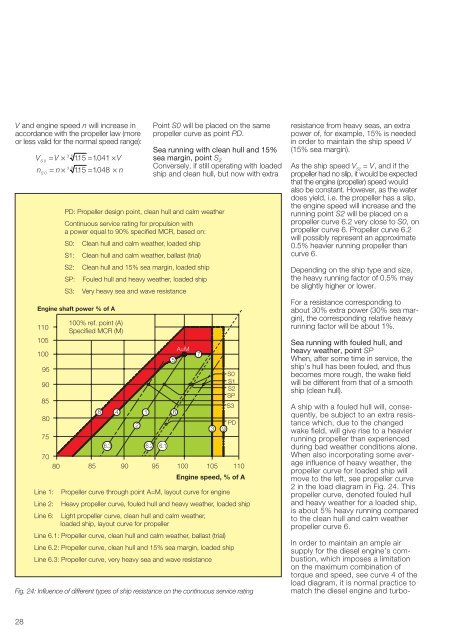
![Conceitos transmissao de dados .Sinais[.pdf]](https://img.yumpu.com/50982145/1/190x146/conceitos-transmissao-de-dados-sinaispdf.jpg?quality=85)
![Packages e interfaces[.pdf]](https://img.yumpu.com/50629553/1/190x134/packages-e-interfacespdf.jpg?quality=85)
